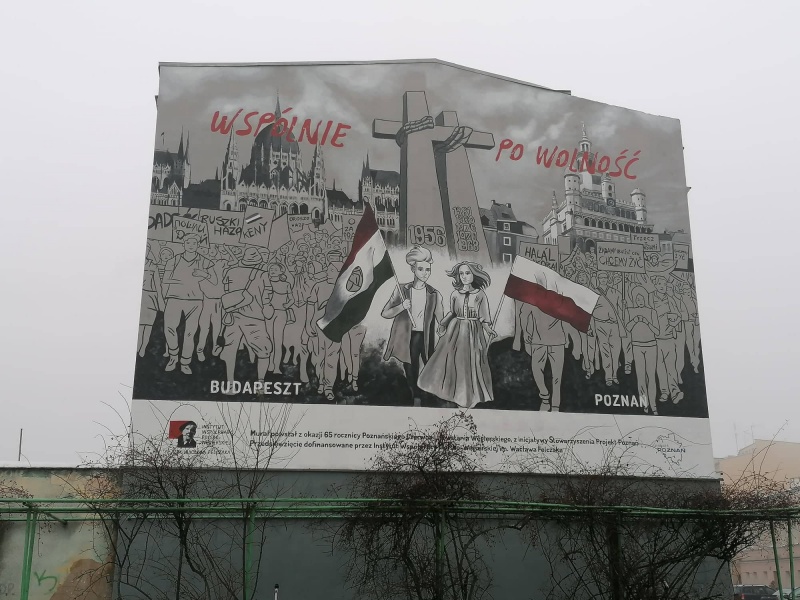The fight for freedom and independence 65 years ago has once again united Poles and Hungarians. On Monday 13 December, on the 40th anniversary of the introduction of martial law in Poland, a mural commemorating the anniversary of the Hungarian Revolution and the Poznań protests of 1956 was officially unveiled at 37 Główna Street in Poznań. “Together for freedom” – reads the slogan visible high over the crowds of Hungarians and Poles gathered on either side of Poznań’s famous crosses.

Mural at 37 Główna Street in Poznań. Photo by Agnieszka Barátka
The Poznań protests of 1956 also ignited hopes for freedom and decent living conditions among the people of Budapest, who began their revolution against the Soviet occupier a few months later, on 23 October. The mural unveiled in Poznań depicts two flags – a Polish and a Hungarian flag with a hole in the middle. 65 years ago, thousands of Hungarians cut such a hole to rid their beloved national symbol of the Communist coat of arms. During that time, the citizens of Budapest and Poznań became united in their common fight against the Soviet occupant.
– Blood was spilled in both these cities. This united us even more. It became apparent that this was not just friendship but also a willingness to make a sacrifice when it had to be made – said Szymon Szynkowski vel Sęk, deputy chief of Polish diplomacy, during the ceremony in Poznań. With these words, the Deputy Minister of Foreign Affairs of Poland made a reference to the extraordinary solidarity of the Polish people with the Hungarians fighting against the Red Army soldiers – their brutal armed intervention resulted in three thousand civilians killed and over ten thousand people wounded. Historians estimate that during the Hungarian Revolution of 1956, almost 800 litres of blood were sent from various Polish cities to Budapest. In total, more than eleven thousand people donated blood in Poland in 1956. The total value of aid donated to Hungarians – food, medicine, money, clothes and toys – amounted to around two million dollars.
The largest number of volunteer blood donors willing to help their Hungarian brothers and sisters arrived at hospitals in Warsaw, Kraków, Katowice, Wrocław, Łódź and Poznań. – The people of Poznań showed great solidarity with the Hungarians, with the wounded and those who lost their lives in Budapest. Poznań residents donated blood in large numbers – explained Jędrzej Solarski, the vice-president of Poznań, speaking on the occasion of the mural’s official unveiling. Agnieszka Barátka, representing the Wacław Felczak Polish-Hungarian Cooperation Institute, emphasised that the project will “contribute to the deepening of the historical identity” among Hungarians and Poles, and will remind us of the common pages of history, as well as of the friendship and solidarity between Poles and Hungarians.
– As part of its activities, the Wacław Felczak Polish-Hungarian Cooperation Institute every year supports a whole range of projects aimed at enhancing Polish-Hungarian cooperation and friendship. In this year’s edition of our programme to co-finance projects undertaken to benefit Polish-Hungarian collaboration, one of our priorities was the commemoration of the Hungarian Revolution of 1956 and the Polish-Hungarian civil and social solidarity of that time.
In 1956, the fates of Poles and Hungarians once again became closely intertwined in history. On hearing of the events in Poznań, Budapest students engaged in a demonstration in solidarity with the Poles. Later, upon hearing about what happened in Hungary, it was the turn of the Poles to pass their own test of solidarity by providing help to the Hungarians who needed it – emphasised Agnieszka Barátka.
The initiative to create a mural commemorating those events came from the “Projekt Poznań” Association as part of the undertaking “United by friendship and solidarity: June & October 1956”. The project was co-funded by the Wacław Felczak Polish-Hungarian Cooperation Institute. The author of the work was Ideamo Murals, which created the mural in cooperation with Zarząd Komunalnych Zasobów Lokalowych (Management Board of Municipal Housing Resources) and Zarząd Dróg Miejskich (Municipal Roads Authority) in Poznań.
(JAP)
(JAP)